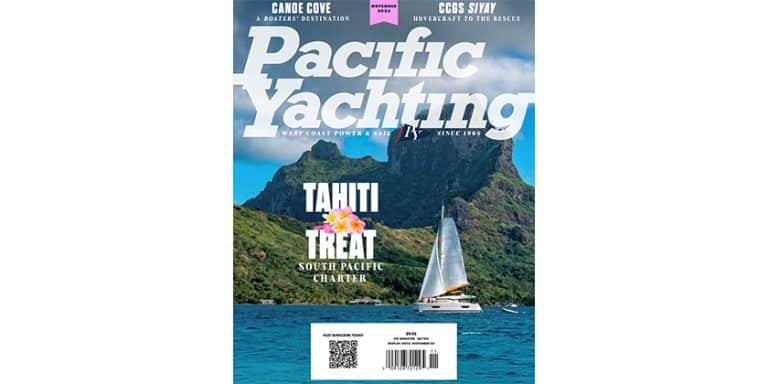Destination Victoria, BC’s Capital City
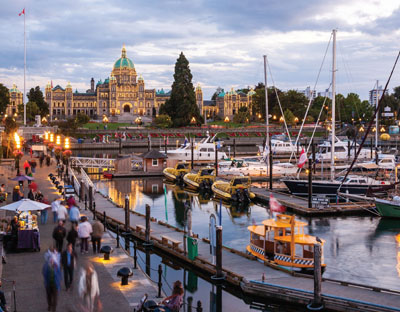
Text and Photos by Marianne Scott
We bobbed in the brisk winds while rounding the breakwater into Victoria Harbour, then lowered sail immediately. As the harbour is crisscrossed by full-sized and miniature ferries, pleasure craft and commercial vessels—the whole supplemented by a stream of arriving and departing seaplanes—sailing is strictly forbidden. We left the yellow buoys to port (the east side): the west side is reserved for floatplanes. For safety, the Public Port of Victoria (Transport Canada) keeps a close eye on all this traffic: 23 always-on-the-job cameras cast their eyes over the entire port, feeding large screens.
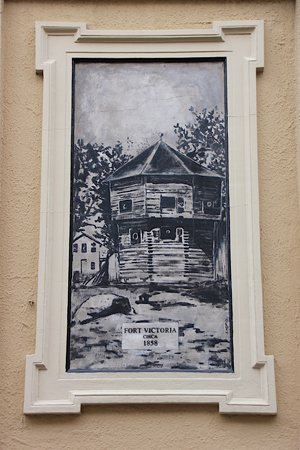
An image of the Hudson’s Bay fort.
Victoria Harbour is well protected from strong winds and Coast Salish people flourished in the area for several thousand years. In 1843, the Hudson’s Bay Co. set up a stockaded fort in the area near today’s Bastion Square with the goal of trading with the Indigenous people. Neither HBC nor the successive settlers that farmed, traded, created sawmills and other industries, built schools and a hospital, asked for permission to occupy the land. Instead, Queen Victoria, who bestowed her name on the city she never saw, gave them permission to seize it.
We slipped past Fisherman’s Wharf filled with all manner of vessels interspersed with float homes and restaurants. Two historic structures popped into sight: The Empress Hotel, built by the Canadian Pacific Railroad in 1908 as one of its Canada-wide chain of luxury hotels, and the BC Parliament Buildings. Both these much-photographed structures were designed by Frances Rattenbury, who arrived in Victoria from England at age 25 and turned the architectural community upside down.
Moorage in downtown Victoria is available at several locations: The Causeway in front the Empress, Ship Point that accommodates yachts 60 feet and more, and at the Wharf Street Floats. Moorage for yachts 65 feet and up can also berth at the Victoria International Marina. These docks are centrally located and have security gates (see sidebar).
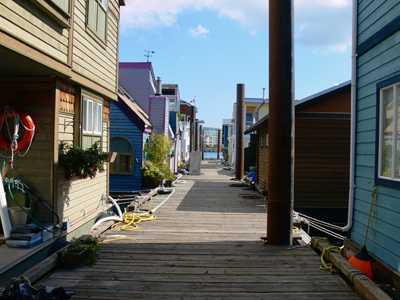 If you look up at Old Town buildings you’ll find all kinds of gablestones and sculptures Floathomes at Fisherman’s Wharf
If you look up at Old Town buildings you’ll find all kinds of gablestones and sculptures Floathomes at Fisherman’s Wharf
We tied up at the floats in James Bay directly in front of the Empress. A bronze, bewigged Capt. James Cook, the first westerner to set foot on Vancouver Island, greets boaters by the staircase leading from the docks, which lie in the midst of the Causeway usually filled with street artists and buskers. And, you’ll see an art-deco building at the top of the Causeway—the Visitor Centre— with much information and maps.
Historic Victoria
Victoria, as the oldest city on Canada’s west coast and BC’s capital, is home to a lively downtown with many of its historic buildings preserved—wonderful sightseeing, museums, theatres, shopping, dining, antiquing, tours, totems and flower gazing begin right at the harbour and extend over a wide and very walkable area. Visitors can easily spend several days wandering around. I advocate that you don’t just keep your eyes at street level—look up the buildings’ façades to enjoy the gargoyle-like sculptures and other decorations.
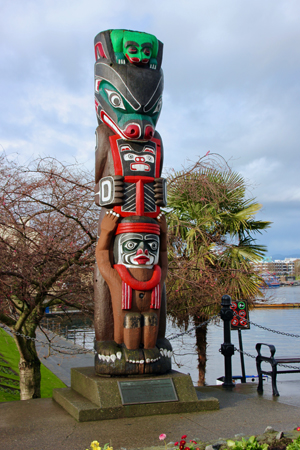 Kwakiutle Bear Pole by Henry Hunt
Kwakiutle Bear Pole by Henry Hunt
A good place to begin learning about BC’s present and past history is at the Parliament Buildings. The impressive structure opened in 1897 and cost a scandalous $923,882.30, including the usual huge overruns. Historic art, a giant Indigenous canoe, the commemorative stained-glass windows and a glimpse of the Legislators’ chamber are impressive. The gilded gentleman guarding the top of the dome is Capt. George Vancouver. Parliament, known for its lighted outlines, was first illuminated to mark Queen Victoria’s Diamond Jubilee on June 21, 1897.
Across the street, the Royal BC Museum is hosting an exhibit on orcas this summer, the iconic marine mammals once hunted to preserve fish stocks, now revered and endangered. Besides that special exhibit, the Museum is home to marvelous collections of First People’s art and totems, dioramas of the Ice Age, BC’s natural and human history, and realistic depictions of life in the 19th and 20th centuries. Thunderbird Park, filled with brightly painted totems, called a “Place of Cultural Sharing,” is located next to the Museum. Also check to see if IMAX, part of the Museum, has reopened.
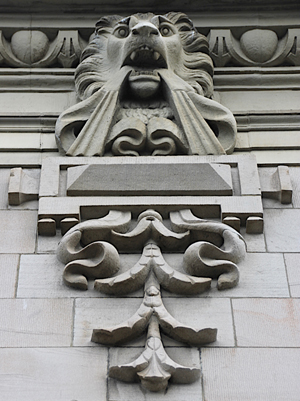 If you look up at Old Town buildings you’ll find all kinds of gablestones and sculptures
If you look up at Old Town buildings you’ll find all kinds of gablestones and sculptures
The Empress Hotel is worth a visit even if you don’t indulge in the popular, but pricy high tea. Outside, a bronze Emily Carr along with her dog and monkey and one of BC’s iconic painters, greets people. Recently revamped, the hotel’s tearoom and Palm Room with its magnificent stained glass ceiling glow with Edwardian elegance. Shops and an arcade lead to the Victoria Conference Centre with some outstanding totems. The sleek structural arches remind me of a Renaissance church.
After exiting the hotel’s lobby, turn north and stroll up Government Street. Its collection of period buildings contains a flock of specialty shops, clothing emporiums, bookstores and pubs. Munro’s Books is a justly famous bookstore for its huge selection; it’s elegantly housed in a former bank. Lovely, hand-woven tapestries by Carole Sabiston decorate the bookstore’s high walls. Right next door is Murchies with the best teas and pastries in the world. And while feeding our sweet tooth, we should visit Roger’s world-famous chocolates in its authentic 19th century setting. Two former banks, impressive with their former solidity and façade sculptures, now host pubs.
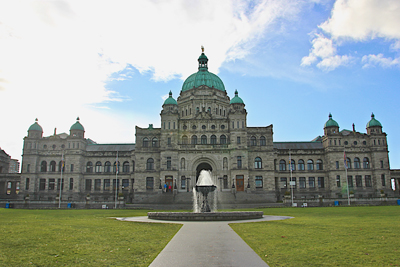 (Right) The BC Legislature Building completed in 1898
(Right) The BC Legislature Building completed in 1898
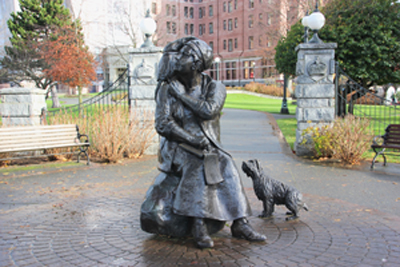 (Left) Statue of Emily Carr with her monkey and dog in front of the Empress Hotel
(Left) Statue of Emily Carr with her monkey and dog in front of the Empress Hotel
Walking further north on Government leads to the cross streets of Yates, Johnson and Pandora, built after the late 1850s gold rush made Victoria the main supply centre for mobs of speculators and gold diggers. Many of the brightly painted and red-brick buildings still lining these streets were built then as hotels, saloons, brothels and trading bazaars. By the mid- 20th century, these streets had grown seedy, even derelict, until such visionaries as Michael Williams and Sam Bawlf saved and rejuvenated the structures, starting a trend. One example of such revamping is Market Square, made up of eight heritage buildings between Johnson and Pandora Streets. It’s one of several places where you can dine, shop for art, trendy clothing, beads and souvenirs.
(Left) Inside the Legislature- the BC crest in stained glass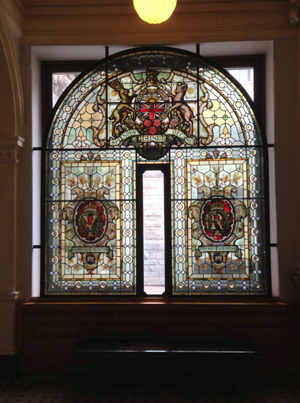
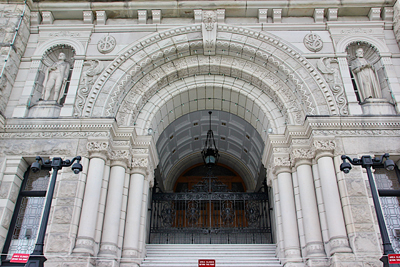
(Right) The formal entrance to the Legislature
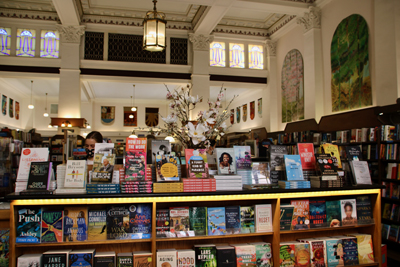
(Right) Inside Munro’s Books, one of Canada’s most famous independent bookstores, housed in a former bank
The Chinese Influence
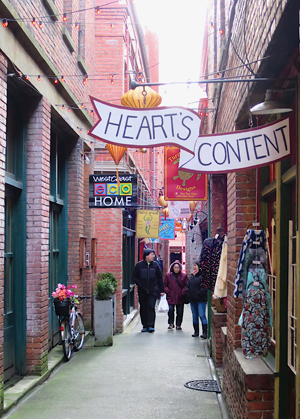 A few blocks further north, you’ll find the Gate of Harmonious Interest flanked by two hand-carved stone lions—it’s the Fisgard Street entrance to the oldest Chinatown in Canada (the second oldest in North America after San Francisco). The gate was constructed in 1981 as a “a permanent monument to mark the harmony of the multicultural society which all Canadians enjoy.”
A few blocks further north, you’ll find the Gate of Harmonious Interest flanked by two hand-carved stone lions—it’s the Fisgard Street entrance to the oldest Chinatown in Canada (the second oldest in North America after San Francisco). The gate was constructed in 1981 as a “a permanent monument to mark the harmony of the multicultural society which all Canadians enjoy.”
Between 1881-84, Victoria became a hub for Chinese migrants with nearly 16,000 passing through to work on the Canadian Pacific Railway. By 1900, about 3,000 Chinese lived in this part of town, and ran schools, theatres, shrines, opium factories and gambling dens. Opium production, sale and export were legal. Many buildings of the era remain and are highlighted with imperial gold and mandarin red enamel. I love ambling among the curio shops, herbalists and Asian grocery stores— their juicy veggies displayed in crates on the sidewalks. Spreading my arms wide, I can finger both walls of Fan Tan Alley—claimed to be the narrowest street in Canada—which runs between Pandora and Fisgard; it was once home to a host of gambling dens but now features boutiques.
Eating in Style
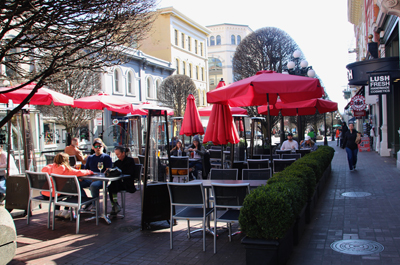
We especially enjoy Victoria’s outstanding variety of restaurants: the city claims to have the second highest number of restaurants per capita in North America. Just about every type of cuisine—in all price ranges—can be found strolling from the Inner Harbour. Among the upscale, the Q at the Empress is known for great dining and is an oenophile’s delight. Il Terrazzo on Johnson cooks Italian. There are many Japanese restaurants; our favourite is Ebizo on Broughton and we’ve gobbled dim sum at Fisgard Street’s Don Mee. If you like tasty vegetarian cuisine, you can’t go wrong at Rebar next to Bastion Square.
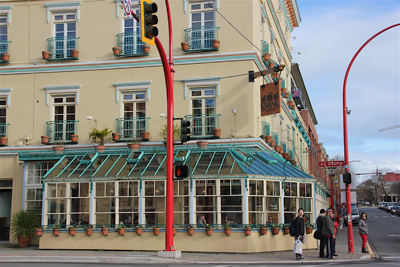 Swann’s Hotel and brewpub dispenses its own craft beer
Swann’s Hotel and brewpub dispenses its own craft beer
If your feet have walked enough, you can have a fun excursion by taking a mini green-and-gold harbour ferry and whip across the Harbour to Spinnaker’s Brewpub with its delectable microbrews (don’t use your dinghy—there’s no public moorage).
Enjoying the Sunshine up the Gorge
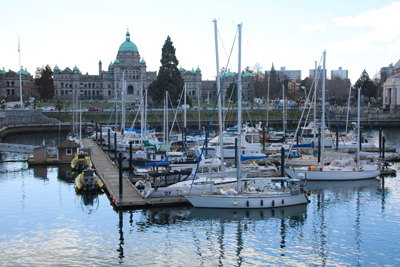
The Marina in front of the Empress and the BC Legislature Building
We like to explore coves and harbors by dinghy which allows us to get close to shore and look at things in greater detail. The sinuous contours of Victoria Harbour invite such journeying. We first skimmed across to eat at Barb’s famous fish-and-chips at Fisherman’s Wharf where visitors from everywhere eat at picnic tables while sparrows pick at crumbs around their feet (there are other eating places here). You can also motor or paddle right under the Victoria International Marina’s buildings and dine in one of them—the Boom and Batten.
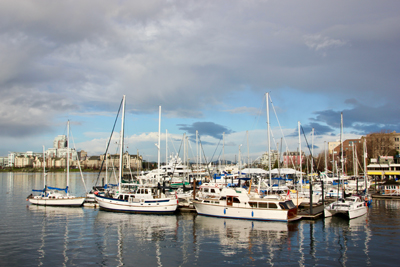 The Causeway Marina in front of the Empress
The Causeway Marina in front of the Empress
The next day, we used our inflatable dinghy to slowly wend our way through the Upper Harbour and watched the cars zoom overhead on the Johnson Street Bridge. We passed the Canoe Brewpub, reconnoitered the Point Ellice Bridge, then pointed northwest into the Gorge. Sneaking through the timbers of the Selkirk Trestle, we left the city centre behind seemingly entering a broad, tranquil river, with undulating eel grass and other water plants swaying in the weak current. At low tide, the Gorge is shallow enough that a dinghy can ground in certain spots. Don’t speed. Tree branches dangled from the home-studded shores and a concert from unseen birds accompanied our peaceful meander. We zigzagged on through to Portage Bay and then leisurely retraced our trail.
In the late afternoon, I stepped back onto bustling Belleville Street—one of Victoria’s oldest streets—and into the 19th century. A horse-drawn carriage carrying a starry-eyed young couple holding hands clip-clopped down the street. If it hadn’t been for the cars zooming by, I might have spotted a bewhiskered captain who’d just brought in a ship loaded with tea and china, or men seeking their fortune in the British Columbian gold fields.
————————————-
Victoria Information and websites
Please check websites below and individual attractions during Covid restrictions. Across from the Empress, the Visitor Information Centre dispenses walking maps, dining guides, guides to bike and kayak rentals, and other useful information, such as visits to the Butchart Gardens.
www.victoria-bc.com/ and www.victoriabc.com/ offer good overviews of activities. www.heritagevictoria.org/ describes historic venues and tours.
www.tourismvictoria.com/ lists attractions and events.
Marinas managed by the Greater Victoria Harbour Authority, gvha.ca/.
Causeway, 30-amp power, showers at the Broughton Street Pier.
Ship Point, for larger yachts.
Wharf Street Public Wharf, 50-amp power, 1,780’ of dock space.
Other Marinas
Coast Harbourside Hotel Marina, coasthotels.com/coast-victoria-hotel-and-marina-by-apa/.
Victoria International Marina for yachts 65 feet and more, vimarina.ca/.
Victoria Harbour is a no discharge zone; pumpout at Fisherman’s Wharf, end of B dock.
Fuel: Victoria Marine Fuels Ltd., at Fisherman’s Wharf, victoriamarinefuels.com/.





